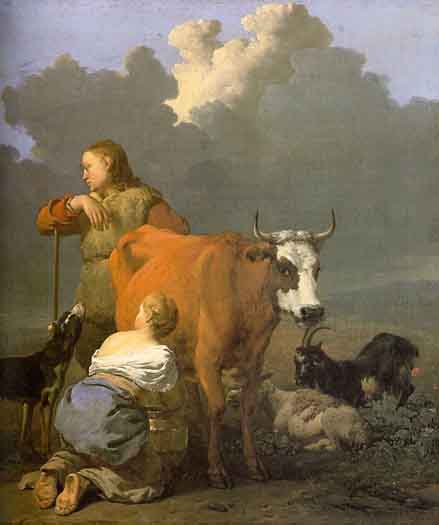Dairy Cattle

One end is moo, the other milk.
by Ogden Nash
The milk most of us drink comes from the udder of a female bovine animal, a cow. The primary purpose for milk is as food for the calf. Although females from all cattle breeds produce milk and meat, some cattle are better at giving milk, and some are better at providing meat. Holstein is the breed that produces the largest quantity of milk.
The dairy farmer's work day begins and ends with milking. Most dairy farmers today use milking machines. One of the most important jobs is keeping everything very clean. That is the only way to make sure bacteria doesn't get into the milk and cause it to spoil. In 1856, Dr. Louis Pasteur discovered that heat kills bad germs. Today we use this process, called pasteurization, to make milk safe to drink.
After the cows are milked, the milk is cooled and stored in a stainless steel tank. The milk stays in the tank until it is time for it to go to the milk processing plant.
When it is time to take the milk to the processing plant, a stainless steel tank truck comes to the farm and pumps the milk from the cooling tank. The truck's tank keeps the milk cool during the trip to the processing plant.
Cows produce twice the amount of milk today as they did during the 1960s. Milk is used to make butter, cheese, ice cream, yogurt and other dairy products. It is also used in the production of nonfood items like glue and other adhesives. One quart of milk weighs 2.15 pounds. It takes about 23 pounds of milk to make one pound of butter. It takes about 12 pounds of milk to make one gallon of ice cream.
Milk was named Oklahoma's official state beverage on November 2, 2002. In 2016, Oklahoma had an average of 37,000 milk cows. Dairy was the 7th most valuable agricultural commodity in Oklahoma in 2015.
Learning Activities
- Smart Board Activity: Coats and Genes (Need help?)Please be patient with us as we learn how to use this new technology.
You must have Smart Notebook software installed on your computer to open Smart Board activities. If you have Smart Notebook software and are using Internet Explorer, you may get a message telling you the activity cannot be opened. In this event, save the activity to your hard drive. Your browser will save it as a zip file. Simply change the "zip" in the file name to "notebook," and you should be able to open it.
Thank you for your patience.
Smart Board Acitivity page - Colorful Cattle
Additional Resources
- Recipe: Ice Cream in a Bag
- Ice Cream in a Bag, Robin Dunn, Laverne
- More Facts about Dairy Cattle
- Books
- Classroom Recipes with Dairy
- Dairy Cattle Breeds
- Recipes: Giant Pizza Pattern
- Southwest Dairy - Schedule a visit from the mobile dairy.
- Songs about Cows
- Agriculture in Poetry: "The Cow"
- Agriculture in Art: Woman Milking a Red Cow, 1650s by Karel DuJardin
 Woman Milking a Red Cow, 1650s by Karel DuJardin
Woman Milking a Red Cow, 1650s by Karel DuJardin
